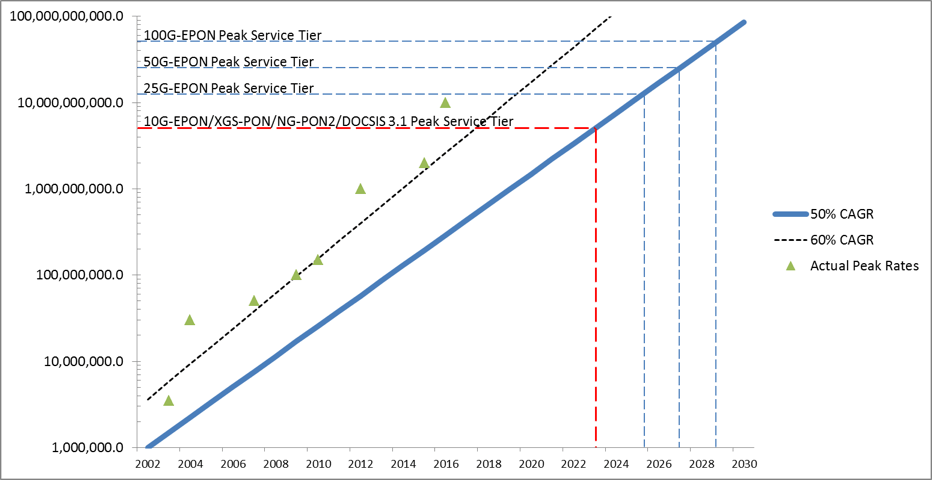Networks
25G/50G-EPON Standard Crosses the Finish Line – Enhancing Fiber Deployments as Part of Cable’s 10G Platform

Nobody knows the extent to which broadband speeds will continue to increase over the next 5-10 years, but service providers intend to be certain that their network solutions will be able to handle whatever is coming. With the announcement of the 10G Platform the cable industry has set a new target for future broadband speeds of at least 10 Gbps, with symmetry being a key component of that new speed target.
Whereas the majority of the cable industry continues to leverage their ubiquitous hybrid fiber coaxial (HFC) networks to provide high-speed data services to a large proportion of their subscribers, fiber to the home (FTTH) solutions that utilize passive optical networks (PON) remain an important component of their solution set. Thus, it is important for FTTH technology to continually evolve in a way that meets future bandwidth demand. I am pleased to announce PON solutions have reached a new milestone in that technology evolution with the recent approval by the Institute of Electrical and Electronics Engineers (IEEE) of the 25G/50G-EPON standard.
Key Features of 25G/50G-EPON
A key requirement for 25G/50G- EPON is it must operate over already-deployed PON infrastructure with the same split ratio and nominal 20km reach as previous generations of technology. Beyond an increase is peak capacity, there are many new features and capabilities built into this standard, some of these features are focused on the efficient use of the available capacity and reducing overhead of the media access control (MAC), while others are focused on coexisting with legacy technologies and low-cost implementations. I will focus on just a few of these enhancements to the standard.
- Peak Capacity: As the name implies, the new EPON standard developed by the IEEE 802.3ca Task Force allows for symmetric or asymmetric operation with downstream speeds of 25 Gbps or 50 Gbps, and upstream speeds of 10 Gbps, 25 Gbps, or 50 Gbps. These peak capacities are more than capable of meeting the 10 Gbps symmetric service tier goals set forth in the 10G Platform. Achieving this increase in capacity is accomplished in two ways: (1) expanding the transmission rate to 25 Gbps per wavelength and (2) leveraging wavelength division multiplexing technology to add an additional wavelength. A benefit of this architecture is that service providers can initially deploy a single wavelength providing 25 Gbps, and then add a second wavelength to bring the total to 50 Gbps upon demand.
- Coexistence: An important consideration for service providers is the ability to support coexistence with legacy PON technologies, specifically 10 Gbps PON. Briefly, coexistence enables reuse of existing PON infrastructure by easily adding additional capacity while avoiding the complete removal of legacy PON technology. For 25G/50G-EPON, service providers who have already deployed 10G PON solutions are able to add one or more 25 Gbps wavelengths to bring total capacity to 35 Gbps or 60 Gbps in total over the same PON infrastructure. Various coexistence scenarios are shown in the diagram below.

- Low-Cost Implementation: The economics of any residential broadband solution are always an important consideration for service providers. For optical solutions such as PON, the optical transceiver on each end of the link is one of the more costly components. Particularly for FTTH PON solutions, it is critical to keep costs as low as possible for the customer premise equipment, the optical network unit (ONU) in the case of EPON. In this regard, 25G/50G-EPON aggressively strives to keep ONU optical component costs low in two key ways: (1) fixed wavelengths, instead of tunable wavelengths, and (2) wideband optics in O-band without dispersion compensation. In fact, in greenfield deployments, e.g. new FTTH builds unburdened with legacy PON technology, a 50 Gbps ONU can use two wideband channel sources to reduce costs instead of two narrowband channel sources or operating 50 Gbps on a single wavelength, as shown in the lower portion of the figure above.
Speed, coexistence and low-cost implementations are only three of the outstanding benefits built into the next generation of EPON. Without a doubt this version of PON technology represents the lowest cost per bit compared with any other PON technology. If you are interested in looking for future activities at CableLabs related to integration of this technology into cable networks or discovering more details about 25G/50G-EPON, please feel free to contact us to receive more information.

Networks
Increase Upstream Reliability and Capacity with Optimized Profiles

Network usage patterns have shifted in unprecedented ways in the last few months with vast swaths of the population staying at home. A substantial increase in network traffic has been observed from homes with people collaborating for work and children learning over the Internet with online school sessions and material. The access networks have seen a transition of the peak weekend levels of traffic become the new normal throughout the week.
In this time of network traffic increase, reliability and capacity are increasingly important. Upstream reliability is fundamental to the network experience as seen by the end user in the home. For DOCSIS 3.1 and 4.0 networks configuring profiles is the key to maintaining a reliable channel while simultaneously optimizing capacity. Profiles define the modulation orders used on the channel, with higher modulation orders allowing for more bits of information to be communicated per modulation symbol.
In a previous blog post, we discussed downstream profile management. In this blog, we focus on upstream profile management which differs from the downstream due to the structure of the Hybrid-Fiber-Coax (HFC) plant and the nature of bursty transmissions from a cable modems (CM).
In the downstream direction, there is one location from where the signals enter the HFC plant, specifically the cable modem termination system (CMTS) in the headend. The operator has control of the signal at that point and along the network, to ensure it reaches every CM. From the head end to the CM, the RF signal fans out in a star topology network in a point to multipoint (P2MP) fashion. It is the opposite on the upstream/return path: the RF signals enter the plant from every home that is attached to the plant, and all of those signals combine together as they travel to the headend. Typical of all P2MP networks, the noise from every device on the network gets combined as it travels upstream and is finally received on the upstream port at the CMTS. This is known as the noise funneling problem, as shown in the diagram below. Thermal noise at the amplifiers and fiber optic link noise are common sources of upstream noise. Other noise sources which ingress into the upstream path include impulse noise from loose connectors, unterminated splitters or taps, cracked cables, common path distortion due to corroded connectors, clipping distortion etc.

Simple HFC diagram showing US Noise funneling
Thus, in the upstream, the noise from every house and every network element gets accumulated and is seen at the upstream receiver on the CMTS. Now a CMTS receiver can measure the received modulation error ratio (RxMER) for each CM, see some example measurements from a live network in the diagram below. In the upstream, this signal to noise signature for each of the CMs (that are sharing the upstream channel) starts looking very similar, as they all share the same noise across the channel with slight differences due to the signal levels itself. This means common profiles can be designed for many CMs experiencing similar noise conditions. Most CMs will be able to use a common profile. For CMs which suffer more noise, they can be put into a different profile optimized for their particular noise environment. The modulation orders within a profile can vary appropriately across the spectrum as per the noise levels in that part of the spectrum.
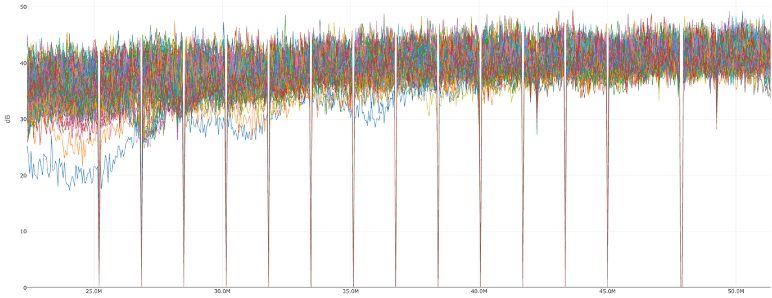
Upstream measured RxMER for CMs on a D3.1 OFDMA channel (Data from a European Operator)
The upstream Profile Management Application (PMA) can automate this design of the profiles on various upstream channels across various segments in the cable plant. Reading the upstream RxMER from the CMTSs on the network, processing the RxMER information with intelligent algorithms to create profiles, and then configuring the newly optimized profiles on the CMTS are the primary functions an upstream PMA solution accomplishes. Configuring optimized profiles brings solid reliability to the upstream network connection and also increases the capacity in parts of the spectrum which can accommodate higher modulation orders.
Many cable operators across the world are now turning on upstream OFDMA channels and leveraging the upstream PMA capability to automate the creation of profiles for their D3.1 upstream OFDMA channels.
If you are interested in discovering more details about upstream or downstream PMA, or setting up a field trial, please feel free to contact us to receive more in-depth information.

Networks
PNM Series: The Business Case for a Common Collection Framework

This is the second in our series on Proactive Network Maintenance (PNM). If you missed our introduction to PNM, you can check out the first entry which explains some background on the subject.
PNM is our CableLabs project focused on assuring cable service provider companies can maintain the network at a level of quality so that major impacts to service are avoided. The proactive part means the maintenance happens before the customer’s service is impacted. But, to do this well, a service provider must collect data from the network. However, collecting data from the network in a way that doesn’t impact service is not easy.
What is the Common Collection Framework?
The Common Collection Framework is a set of Python software modules that handle the task of collecting PNM data from the network elements and presenting the data to PNM applications. It provides the data in a common form so that software applications don’t have to talk network language to get the data it needs. It also protects the network from overly frequent data requests, which can impact service.
CableLabs created a DOCSIS® Common Collection Framework (DCCF) and a Wi-Fi Common Collection Framework (WCCF). We have also started the creation of an optical-centered collection framework. We may even create an in-home wired (MoCA) framework if members express the need. To keep the usage model simple, CableLabs intends to join these frameworks into a combined Common Collection Framework (XCCF). Because cable services are provided over a network comprised of many different technologies, CableLabs is making it easy for members to use the right mix of collection frameworks to get data from the right network elements for their needs.
CableLabs recently released an architecture document to the public that describes the DCCF in detail. You can obtain a copy at this link and reference it in your work. The document describes what the DCCF is, as well as the intended architecture for XCCF. There is also a partner document reporting on the Wireless Common Collection Framework, available here.
What’s Under the Hood?
Briefly, the XCCF is a set of Python modules that work in concert to set up the network for polling using Simple Network Management Protocol (SNMP), manages requests for PNM data, and stores Trivial File Transfer Protocol (TFTP) output in native form or SNMP results in JavaScript Object Notation (JSON) files. If that seems confusing, just know that we are providing the network data in easy to use forms. Applications can then request data from the XCCF data based on time parameters and data types. So, if the needed data are already there, the applications can receive what they need right away. Or, if the data are not there, then the XCCF can obtain the needed data and provide it in a timely manner. There are a lot of actions that can go wrong in these transactions, so CableLabs has worked hard to build a flexible architecture that supports many possible PNM approaches.
Because the PNM data are presented in the formats presented by the network, existing applications shouldn’t have trouble connecting to the XCCF to obtain its data. Translator software takes the output from the network and gets it ready for applications to use.
Why did CableLabs build it?
A PNM application or program needs data to drive it - obtaining the data required can be a significant request to network elements. Service providers need to know that the network isn’t impacted by PNM requests, so they need some level of control to assure service is the priority. Further, there are potentially numerous PNM applications that need the same data, so having every application impact the network in uncoordinated ways is not efficient, and not necessarily customer friendly. A PNM program that utilizes multiple applications needs a common collection capability to support the applications and relieve the network.
There are clear advantages to using the XCCF to support network operations:
- It provides one polling mechanism to manage, serving all applications.
- Building your own applications, and supporting purchased applications, becomes easier with the XCCF.
- The network isn’t overly taxed with data requests, so it can be ruled out as a cause when there is a problem.
- You get clear separation from the network and the applications, which fits the way operations are usually organized.
- Updating is easy between the applications and the network when you have the XCCF as the point to manage those changes, and XCCF is built to support that.
- XCCF is extensible, and we have loads of great ideas to consider on the roadmap.
- Because XCCF is based on SDN architecture concepts, scaling is understood, and high reliability is supported.
- Because it is accessible by all CableLabs members, any member can use it to test out a PNM capability in a field trial to learn about its benefits to their business.
There is quantifiable business value here too!
- Testing a new PNM capability within operations is easier and more realistic when the data are already presented to the applications in a common way, reducing the uncertainty in the payback of a PNM business case.
- Using the XCCF can streamline implementation of PNM applications in a PNM program, making the business case for PNM pay back faster.
- CAPEX is lower because simpler, cheaper PNM solutions can enter operations and scale better when small applications can be pointed to existing XCCF instances.
- OPEX is lower because applications are separate from the network, and the XCCF interface can be rapidly, easily maintained.
- PNM advantages are achievable because a significant effort in any PNM program is solved with the XCCF. It avoids scaling risks that could otherwise increase the OPEX of a PNM program.
For all these reasons, CableLabs heard from our members that an XCCF capability was needed, so we responded.
Where do I get a copy?
CableLabs members can obtain a copy here. Vendors who are willing to sign the necessary CableLabs agreements can also obtain a copy. We hope our community can contribute feedback, and potentially contribute code as well, to the XCCF. We also look toward the community to drive our roadmap for the XCCF, providing input to what capabilities need to be supported with the highest priorities.
Don't forget to subscribe to our blog to read more about PNM in the future.
Innovation
CableLabs Announces an Open Source LoRaWAN Network Solution

The Internet of Things (IoT) is a growing industry comprised of a massive number of devices that connect to each other to benefit our lives. Examples of these include the Nest thermostat, security cameras, Amazon’s Alexa, and Apple Watch. Refrigerators can talk with the internet to order milk and Fitbits tell you when to step more to meet your daily exercise goals.
A new area of IoT involves the use of sensors designed to last for years on a single battery transmitting information periodically over long distances. The infrastructure to support all of these connected devices is commonly referred to as a Low Power Wide Area Network (LP-WAN).
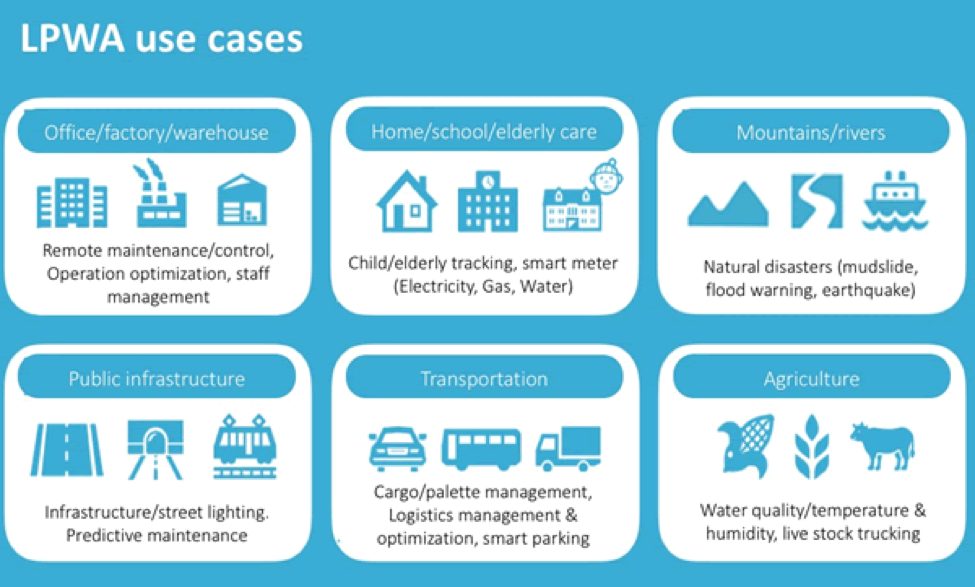 Figure 1 - LPWA use cases graphic by LoRa Alliance member Actility at the occasion of its collaboration with Softbank in Japan
Figure 1 - LPWA use cases graphic by LoRa Alliance member Actility at the occasion of its collaboration with Softbank in Japan
LP-WAN networks are designed to cover large geographical areas and minimize the amount of power required for sensors to interact with the network. There are many solutions available to enable this network, including Ingenu, Sigfox, LoRaWAN, 3GPP and Weightless.
CableLabs is pleased to announce an open-source LoRaWAN solution. LoRa is a semi-proprietary solution as it is owned and licensed by Semtech, and a closed consortium (i.e. LoRa Alliance) develops the LoRaWAN specification around the Semtech solution architecture.
Once the consortium concludes a revision of this effort, they make it publicly available. Ingenu and Sigfox are examples of fully proprietary solutions with closed development and ecosystems. In an effort to be more open, they have software development kits available for sensor manufacturers to create sensors for their networks. Of course, these are merely examples of many more solutions emerging in this space. All of them are attempting to create their own advantage and benefits for network providers and consumers. We attempted to highlight some of the more commonly known solutions available, but these are not meant to be preferential or endorsed by CableLabs and are not an exhaustive listing.
LoRaWAN is a long range, low power wireless protocol that is intended for use in building IoT LP-WAN networks. IoT devices send small data packets to any number of “gateways” that may be in the several-kilometer range of a sensor via the LoRaWAN wireless protocol. The gateways then use more traditional communications such as wired Internet connections to forward the messages to a network-server which validates the packets and forwards the application payload to an application-server.
CableLabs chose to develop a LoRaWAN open-source solution because we believe it is a good compromise between proprietary and open solutions, and it provides many of our members an opportunity to compete in the low power wide area (LPWA) space.
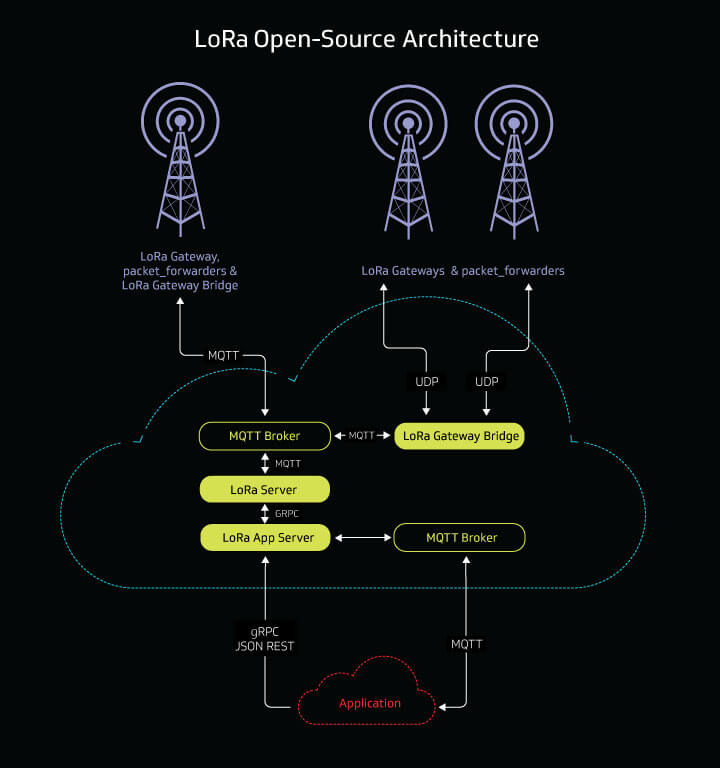 Figure 2 - LoRaWAN Example Network Architecture
Figure 2 - LoRaWAN Example Network Architecture
In the past, CableLabs has often developed solutions specific to the cable industry, but we believe open-source provides consumers a great benefit as it will spur growth in an industry intended to enrich our lives. This enrichment comes through devices intended to inform us of many things. For example, many of us have driven by a city park during a rain storm and noticed the sprinkler system running. This is a waste of water and further impacts our climate. What if we had soil moisture sensors that could communicate with a sprinkler controller to inform it when it requires water? This could save countless gallons of water, which is extremely valuable, especially in drought-stricken regions.
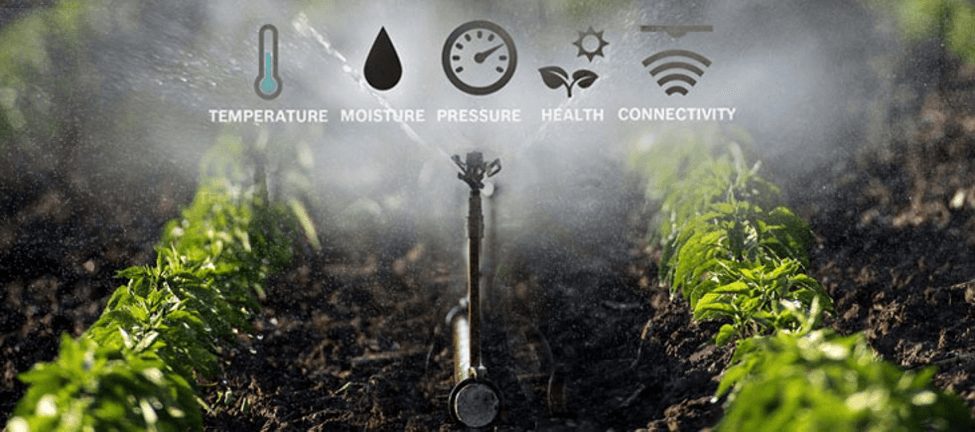 Figure 1 - LPWA use cases graphic by LoRa Alliance member Actility at the occasion of its collaboration with Softbank in Japan
Figure 1 - LPWA use cases graphic by LoRa Alliance member Actility at the occasion of its collaboration with Softbank in Japan
Another example could be to inform a loved one when an aging relative has taken their pills for the day, gets out of bed or sits in a chair too long. All of these are examples of the benefits of sensors enabled by LP-WANs.
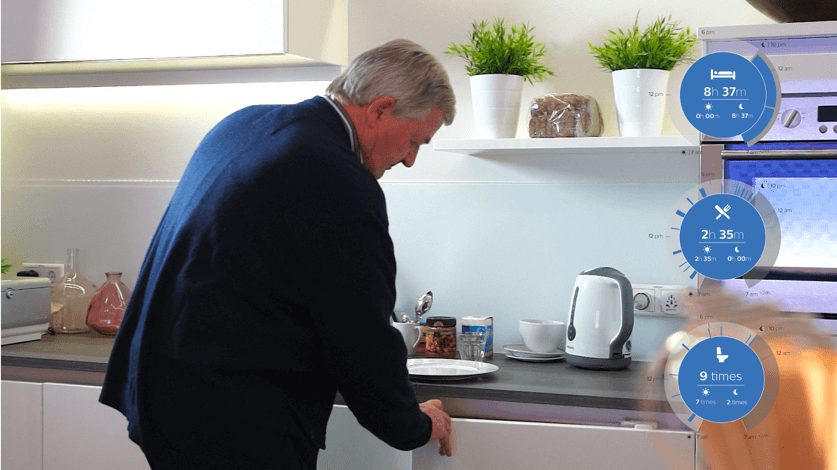 Figure 4 - Philips CareSensus Solutions
Figure 4 - Philips CareSensus Solutions
In order for us to realize these benefits, LP-WANs need to be deployed broadly across national and international regions. This will enable the use of many sensors across these same regions. As we make use of the sensor data, it will enrich our lives with information to make better choices, ensure higher quality results and guide us towards a better future. By making a portion of this network available for open-source, our goal is to lower the barrier for the cable industry and other industry participants to enable these solutions for consumers and governments. Together we can truly change the world, and it should not be limited by costly barriers.
-
More information on the CableLabs LoRa server, including documentation and code repository, can be found here.
With a strong focus on innovation, CableLabs develops technologies and specifications for the secure delivery of high-speed data, video, voice and next generation services. Don't forget to subscribe to our blog to read more about our innovative technologies in the future.
Networks
Network Operator Perspectives on NFV priorities for 5G

Today, twenty-three network operators published a white paper to guide the industry on priorities for NFV to deliver the industry vision for 5G systems: "Network Operator Perspectives on NFV priorities for 5G". The network operator co-authors include Bell Canada, BT, CableLabs, CenturyLink, China Mobile, China Unicom, Colt, Deutsche Telekom, KDDI, KT, NTT, NTT DOCOMO, Orange, Portugal Telecom, Rogers, SK Telecom, Sprint, STC, Swisscom, Telecom Italia, Telefonica, Telenor, and Vodafone. As managing editor for this white paper, I worked closely with colleagues from these leading organizations to document some key consensus requirements that we want the 5G standards community to take into account in their upcoming specification work.
We believe the evolved 5G network will be characterized by agile resilient converged fixed/mobile networks based on NFV and SDN technologies and capable of supporting network functions and applications encompassing many different networks and services domains. The breadth of foreseen 5G use cases and environments implies high scalability, ultra-low latency and ability to support a massive number of concurrent sessions, as well as ultra-high reliability and security. To achieve these ambitious goals, Network Slicing, Cloud-native design principles, End-to-end Service Management, Edge Computing, RAN Cloudification, Multi-site/domain Services, NFV License Management, Security, Reliability, and Scalability are important enablers as outlined in some detail in this paper.
In an era of increasingly stretched resources, it is vitally important for standards development organizations and open source communities to avoid re-invention and wasteful duplication of effort. Hence, an important message is to encourage reference to the extensive body of foundational NFV specification work already published by the ETSI NFV Industry Specification Group over the past four years as the basis for 5G.
As managing editor, I believe this white paper should be used as guidance for the wider industry on how NFV should be used to realize 5G use cases.
What is CableLabs Doing in this Space?
The cable network will provide an ideal foundation for 5G because it is ubiquitous and already supports millions of Wi-Fi nodes in places where the majority of wireless data is consumed. It has high capacity for both Access and Backhaul. It is highly reliable and has low intrinsic latency because it is based on optical fiber which penetrates deep into the access network feeding wideband coaxial cables reaching all the way to the end-user premises. Moreover, it is a multi-node remotely powered access topology ideally suited to support the connection of the large number of small cells close to homes and businesses that will be needed for 5G.
A multi-faceted CableLabs R&D program is addressing the key technologies required for 5G around NFV and SDN that we are executing on behalf of our cable operator stakeholders. For example, CableLabs is progressing an intensive study of virtualized provisioning of the cable access network to enable programmability, our NFV/SDN reference platform is based on OPNFV and we are looking ahead to support 5G using an end-to-end virtualized architecture that includes low latency edge compute nodes located at the cable head-end. In addition, we are seeking to accelerate NFV/SDN interoperability through CableLabs’ Kyrio subsidiary which has built an interoperability lab where vendors can work together with operators to toward their NFV and SDN solutions.
By Tetsuya Nakamura, Principal Architect, Strategy & Innovation, CableLabs
Consumer
Multiple Access Point Architectures and Wi-Fi Whole Home Coverage


As mentioned in a previous blog post on AP Coordination by my colleague Neeharika Allanki, homes sizes are growing and the number of client devices in a home network are increasing exponentially. There is a need for not only consistent performance in terms of throughput and connectivity, but also Wi-Fi coverage throughout the home. Consumers often need more than one Wi-Fi Access Point (AP) in the home network to provide that coverage.
Many houses in the world do not have existing wires that can be used to network these APs together, and so one of the easiest and most cost effective ways to provide whole home Wi-Fi coverage is by using Wi-Fi itself to connect together the APs in the home. The technologies available today that can do this are Mesh APs (MAPs), Repeaters or Extenders.
Wireless repeaters and extenders have been around for years due to consumers seeing the need to expand Wi-Fi coverage in their homes. While some form of wireless mesh networking has been around for more than ten years, until recently there were not products designed for the home that used mesh to connect multiple APs. In the past year, there has been a dizzying array of product announcements and introductions for home Wi-Fi coverage, with many of them using mesh networking.
Mesh Access points (MAPs) are quickly gaining traction in home networks mainly due to ease of installation (even over Repeaters/Extenders) and the promise of high throughput with whole home coverage. A mesh AP network can be defined as a self-healing, self-forming, and self-optimizing network of MAPs. Each MAP can communicate with others using smart routing protocols and thereby choose an optimal path in order to relay the data from one point to another.
As mentioned before in our AP Coordination blog, client steering (moving Wi-Fi clients to the best AP in each location) and band steering (moving and keeping Wi-Fi clients on the best band: 2.4 GHz or 5 GHz) are very important in any multi-AP solution, such as mesh or an AP + repeaters/extenders network. This is needed to ensure that each mobile client stays connected to the best AP for its current location. Without client steering, Wi-Fi clients may show connectivity to Wi-Fi, but throughput may suffer tremendously. This often shows up as the dreaded “Buffering…” message when streaming a video or a slow progress bar when loading a web page. In a fully wireless multiple AP solution, client steering and band steering is even more critical due to the throughput and latency penalty when traffic is repeated over Wi-Fi from one AP to another. As MAPs communicate with each other to form the mesh network, they implement some form of AP Coordination, and it is usually proprietary in nature.
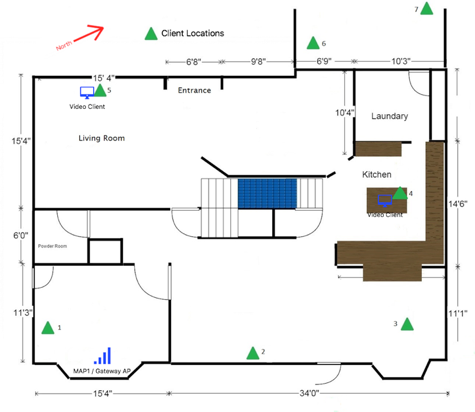
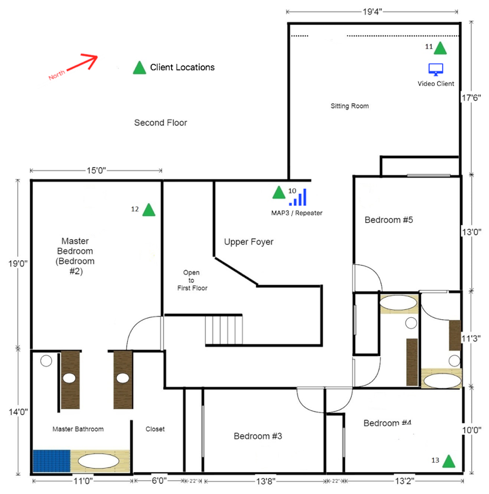
CableLabs recently tested mesh networking solutions and AP + repeater solutions consisting of 3 APs in a 5000+ sq. ft. test house. We performed throughput, jitter, latency and coverage testing at more than twenty locations in and around the house. We found that we were able to run two streaming videos, at HD bitrates (~20Mbps), to video clients in the home while also delivering over 50Mbps to our test client. Both mesh and AP + repeater solutions were able to handle this video throughput, as well as deliver over 50Mbps throughput throughout the house and even to some areas 20’ outside the house. This is excellent news for consumers whose access to the Internet is wireless and who want that access everywhere in their homes.
Next Steps
CableLabs is working with vendors to define a standardized AP Coordination Protocol that would allow all APs in a home network to share information to allow them to make client steering decisions, along with other network maintenance tasks.
DOCSIS
Full Duplex DOCSIS® Specification Effort Launches

During the CableLabs 2016 Winter Conference, CableLabs announced the Full Duplex DOCSIS (now a part of DOCSIS 4.0 technology) specification project that will significantly increase upstream speeds on the DOCSIS network. The announcement of the Full Duplex DOCSIS (now a part of DOCSIS 4.0 technology) extension of the DOCSIS 3.1 specification, and its potential of offering multi-Gbps symmetric services over the HFC network, created a lot of excitement in the industry. Since then a lot has been going on behind the scenes.
CableLabs has been actively collaborating with the vendor community to further refine the concept and system architecture of a Full Duplex DOCSIS (now a part of DOCSIS 4.0 technology) system. The ecosystem support for the Full Duplex DOCSIS technology (now a part of DOCSIS 4.0 technology) has been staggering, with many vendors collaborating and contributing to the development of the technology. A recent example is Cisco’s contribution of a new silicon reference design of a digital echo canceler that maximizes the use of HFC capacity to provide a scalable multi-gigabit return path.
In June, CableLabs officially launched the Full Duplex DOCSIS (now a part of DOCSIS 4.0 technology) project, transitioning it from the innovation phase to the R&D phase focused on specification development. Our first face-to-face meeting held in Louisville last month featured strong participation from CableLabs members and the vendor community including several new participants. Working group meetings will be held on a regular basis until the specification development is complete.
Full Duplex DOCSIS technology (now a part of DOCSIS 4.0 technology) will radically change the art-of-the-possible on the HFC network by delivering an unparalleled experience to cable customers.
Networks
Keeping Pace with Nielsen’s Law
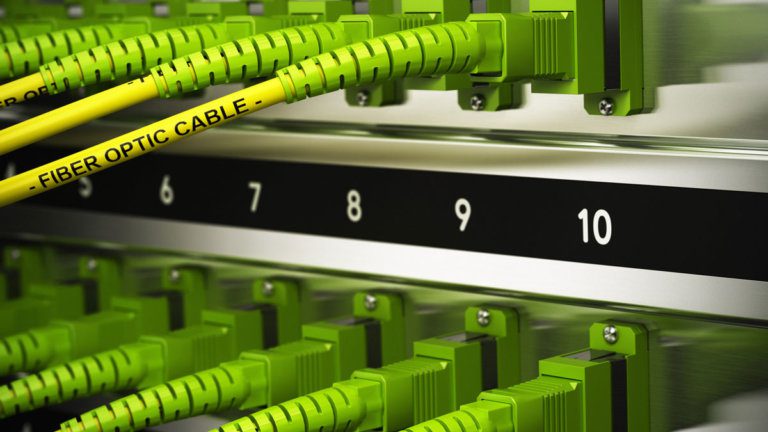
The telecommunications industry typically uses Nielsen’s Law of Internet Bandwidth to represent historical broadband Internet speeds and to forecast future broadband Internet speeds. Mr. Nielsen predicted many years ago the high-end user’s downstream connection speed grows by approximately 50% compound annual growth rate (CAGR). In reality, actual peak service tiers offered by service providers over the years may be following something closer to 60% compound annual growth rate, as shown in the figure below.
The point of this blog is not to debate whether the growth rate is 50% or 60%, but rather if the growth rate continues, how do we evolve our networks to keep pace?
For point-to-multipoint networks there is a general rule of thumb for determining the peak service tier given a particular peak network capacity. This capacity-to-peak-tier ratio of 2:1 isn’t necessarily based in scientific fact, but comes from years of experience that a 2:1 ratio allows service providers to have a reasonable level of confidence that speed test measurements will accurately reflect a user’s subscription level. For example, for a particular access network technology, if the network supports 2 Gbps transmission rates to/from the access termination device (i.e., a cable modem) then the peak service tier typically won’t exceed 1 Gbps.
The present state of the art access network technology peaks at 10 Gbps[1]. The IEEE 802.3 10 Gbps Ethernet Passive Optical Network (10G-EPON) has been deployed in China and the United States. ITU-T has recently consented XGS-PON, another 10 Gbps symmetric PON standard that uses the physical layer of XG-PON (ITU-T G.987.2) and 10G-EPON. Even the ITU-T’s NG-PON2 standard, which uses multiple wavelengths to increase network capacity, only defines a single wavelength per optical network unit (ONU), which puts NG-PON2 on par with 10G-EPON and XGS-PON in terms of meeting peak service tier rates. Finally, CableLabs is now certifying DOCSIS 3.1 devices which are capable of 10 Gbps downstream, and soon will certify 10 Gbps symmetric devices based on Full Duplex DOCSIS technology. What does this mean for accommodating Nielsen’s Law? Assuming the peak service tier trends continue, and given the 10 Gbps peak network capacity of current solutions, the maximum peak service tier will level off at approximately 5 Gbps (see red dashed line in chart above) until technology advances to allow higher rates. The telecommunications industry needs a technology roadmap beyond the current state of the art which allows for peak service tiers to exceed 5 Gbps.
CableLabs and its members, along with other service providers and the IEEE, are determined to stay ahead of the trends displayed in the graph above by contributing to the world’s first 100 Gbps EPON solution as part of the IEEE 802.3ca Task Force. The prevailing sentiment of the 802.3ca Task Force is to create a generational standard that allows for growth of peak network capacity (and corresponding peak service tiers) if and when such growth becomes necessary, without creating a new standard. This growth is expected to be achieved through defining four wavelengths, with each wavelength supporting 25 Gbps. Initial product developments will revolve around a single wavelength to provide a 25 Gbps EPON solution. When market conditions demand it, using two wavelengths along with a channel bonding solution will allow an ONU to transmit and receive at up to 50 Gbps. Similarly, with four wavelengths and channel bonding the ONU will transmit and receive at up to 100 Gbps. Examining the chart above, and assuming historical trends continue, the reader can see the 100G-EPON standard will support peak service tiers out to approximately 2030, give or take a couple years, assuming the 50% CAGR predicted by Nielsen continues.
One of the interesting facets of the 802.3ca Task Force activities relates to the improvement in efficiencies in the media access control (MAC). Previously, the IEEE 802.3 standard did not allow frame fragmentation, but recently with the completion of the IEEE 802.3br Interspersing Express Traffic Task Force, frame fragmentation is now allowed in networks based on the 802.3 standard. The 802.3ca Task Force plans to leverage fragmentation to make transmission more efficient in a multi-wavelength, channel-bonded environment. Additionally, contributions to the 802.3ca Task Force will improve the efficiency of the upstream bandwidth allocation process by allowing multiple service flow queue depth reporting and upstream granting in a single message pair. Considering the ITU-T SG15/Q2 is also investigating 25 Gbps per wavelength, the more promising and exciting aspect of these 802.3ca Task Force decisions is that the next generation of IEEE EPON and ITU-T GPON standards could be more closely aligned than ever before in the very near future! This makes a converged optical access solution closer to reality. (see a previous blog regarding a converged optical access initiative)
In his role as Vice President Wired Technologies at CableLabs, Curtis Knittle leads the activities which focus on cable operator integration of optical technologies in access networks. Curtis is also Chair of the IEEE 802.3ca Task Force.
[1] I’m ignoring point-to-point fiber solutions such as Active Ethernet because these are not typically residential solutions.
Networks
A Re-Cap of FTTH Connect 2016
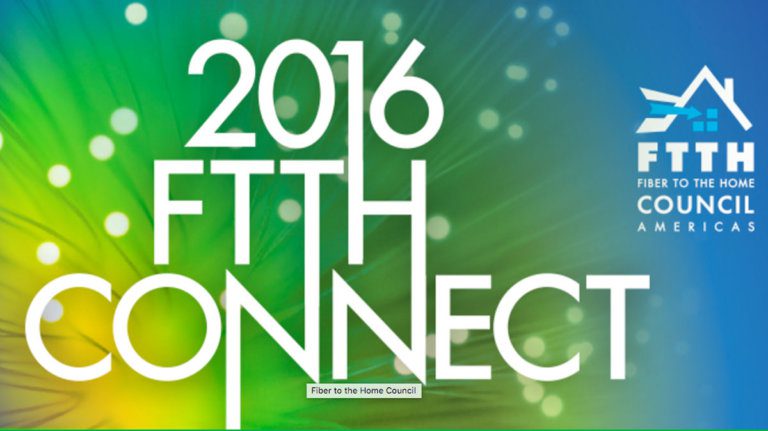
FTTH Connect was held earlier this summer in Nashville. Representing CableLabs and educating the audience about initiatives within the larger cable industry, Steve Burroughs, Curtis Knittle and I spoke at several sessions. In this short video, Steve, Curtis and I will share what we discussed and observed.

Video Transcript
Curtis Knittle: I'm Curtis Knittle from the Wired Technologies Group here at CableLabs. I'm sitting here with Mr. Steve Burroughs (Lead Architect) and Mr. Jon Schnoor (Senior Engineer).
How do you think your activity went at FTTH Connect?
Steve Burroughs: I thought it went really well. We had a good turnout. The numbers that were projected by the the moderator actually were exceeded by about twenty-five percent. We had a lot of questions afterwards and I thought, by and large, we conveyed a lot of information and it was well-received.
Curtis: How do you think it went for you, Jon?
Jon Schnoor: It went very well. It was good to be there representing the cable industry.
Curtis, how did we get into the position this year by having so much presence? What's the history of this?
Curtis: That's a good question. It all started pretty much back in 2014. I gave a presentation and I was basically the only cable operator to do such a presentation and so that was 2014.
In 2015, we had you guys. We had two speakers there doing a panel and we realized based on the feedback from 2014 & '15 that people were clamoring for more information. So this year we proposed a cable track and even a cable keynote. This year we had a total of seven speakers talking on anything from future technologies like 100-gig EPON to provisioning. Of course, the operator keynote was really key to providing some good information for the attendees.
Jon: Guy McCormick, Vice President at Cox Communications. The cable industry was represented by an actual keynote at the show.
Curtis: What kind of things did you talk about Steve?
Steve: We had four people on our panel. And my particular area was addressing one of the needs that comes up with deploying FTTH that is not often thought of. Deploying fiber is a lot more than just trenching and managing layer two protocols and OLTs and ONUs but there's also some higher layer aspects that rely on the access network. In this case, I was speaking about provisioning. And I addressed some of the things that CableLabs is developing at this time that is moving the dependency of the provisioning methods on the access network -- which is currently DOCSIS. I'm making it more independent so I talked about a more modern mechanism that's access network-independent for provisioning the devices that are going to be attached -- whether it's via fiber or DOCSIS. And I also addressed dynamic service provisioning, which is going to take advantage of SDN as well as NFV -- ultimately replacing some of our older virtualization mechanisms.
Curtis: How about you, Jon?
Jon: I spoke about fiber parity in the cable industry. And so we're talking about phone services, internet services and video services and providing those services over fiber -- full fiber networks and fiber-to-the-home (FTTH) implementations. The idea is whatever we're doing in an HFC in a cable network, a traditional cable network, we need to be able to do the same things in an all-fiber network. I spoke about the parity between the fiber network and the HFC network and how do we get there from a fiber perspective.
Curtis: Creating the same services in the same experience.
Jon: Exactly.
Steve: I understand you also led a session?
Curtis: Yes, I did. I did two sessions. One session was on the 100 gigabit Ethernet Passive Optical Networking (EPON) and the standardization activities that are underway right now. And then I had another session that was the operator perspective on fiber-to-the-home.
Our motivation really was to give more exposure to fiber-to-the-premise (FTTP) whether that's home or businesses, give more exposure to the cable industry in what's actually happening because historically I think that show has been mostly telco and municipalities. We're now trying to ramp up some of the cable presence so that vendors and other operators and whoever is involved in the industry can actually start giving some thought to what the cable industry needs as well.
Networks
Cable Makes Its Mark at FTTH Connect

Over the past two years, members of the CableLabs Optical Technologies team had the privilege to speak at the Fiber-To-The Home (FTTH) Council’s yearly FTTH Connect event. FTTH Connect annually attracts many thought leaders from both the vendor and service provider communities.
One observation we made while attending FTTH Connect was the growing appetite of FTTH Connect attendees to learn more about cable industry initiatives and solutions. Not only were the presentations well attended, but in one instance the Q&A session lasted for 30 minutes past the allotted time. Presentations provided FTTH perspective in a cable network, motivation for fiber deployments to complement the HFC network, PON traffic modeling, and supporting cable’s triple play services with fiber home run implementations. This appetite for more cable knowledge was somewhat surprising but welcome.
The impetus for CableLabs’ involvement was not only to show the world that the cable industry is pushing FTTH solutions, but also to introduce the FTTH community to CableLabs as a leader of innovation and R&D solutions. CableLabs has introduced several solutions to provide a means and support strategies of operators for pushing fiber deeper into the HFC network, including FTTH. These solutions include DOCSIS Provisioning of EPON (DPoE), Triple Play over PON and the group of specifications based on the Distributed CCAP Architecture.
Based on the show in 2015, we set out to increase our contributions at the 2016 FTTH Connect event. We proposed an entire cable track to the FTTH Council and were unanimously approved. We then set out to offer cable’s story at this year’s conference. It begins with Guy McCormick, Senior Vice President at Cox Communications, who will be one of the shows keynote speakers. Cox Communications is one of the most forward-thinking cable companies in the world, and they have an aggressive strategy around FTTH deployments. Jon Schnoor will discuss how we achieve fiber parity with cable services to that of the HFC access network. Steve Burroughs will present how to move beyond technology specific provisioning and work toward an access network agnostic infrastructure through virtualization. Curtis Knittle will explore next generation PON solutions that will establish 100 Gbps EPON and include an operator’s perspective on their transition to FTTH including challenges, technology tradeoffs, operational challenges and solutions. Curtis Knittle is also hosting a panel regarding FTTH in cable, that will explore an operator’s perspective.
If you’re planning to attend FTTH Connect 2016, be sure to attend the cable industry sessions to see what is cool and interesting!


